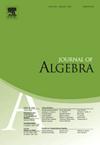Essential semigroups and branching rules
IF 0.8
2区 数学
Q2 MATHEMATICS
引用次数: 0
Abstract
Let be a semisimple complex Lie algebra of finite dimension and be a semisimple subalgebra. We present an approach to find the branching rules for the pair . According to an idea of Zhelobenko the information on restriction to of all irreducible representations of is contained in one associative algebra, which we call the branching algebra. We use an essential semigroup Σ, which parametrizes certain bases in every finite-dimensional irreducible representations of , and describe the branching rules for in terms of a certain subsemigroup of Σ. If is finitely generated, then the semigroup algebra corresponding to is a toric degeneration of the branching algebra. We propose an algorithm to find a description of in this case. We give examples by deriving the branching rules for , , , , and .
基本半群和分支规则
设g为有限维的半单复李代数,h为半单子代数。我们提出了一种寻找g、h对分支规则的方法。根据Zhelobenko的思想,g的所有不可约表示对h的限制信息包含在一个结合代数中,我们称之为分支代数。我们使用了一个本质半群Σ,它参数化了g的每一个有限维不可约表示中的某些基,并用Σ的某个子半群Σ '描述了g、h的分支规则。如果Σ ‘是有限生成的,那么对应于Σ ’的半群代数是分支代数的一个环退化。在这种情况下,我们提出了一种算法来查找Σ '的描述。我们通过推导An、An−1、Bn、Dn、G2、A2、B3、G2和F4、B4的分支规则给出了例子。
本文章由计算机程序翻译,如有差异,请以英文原文为准。
求助全文
约1分钟内获得全文
求助全文
来源期刊

Journal of Algebra
数学-数学
CiteScore
1.50
自引率
22.20%
发文量
414
审稿时长
2-4 weeks
期刊介绍:
The Journal of Algebra is a leading international journal and publishes papers that demonstrate high quality research results in algebra and related computational aspects. Only the very best and most interesting papers are to be considered for publication in the journal. With this in mind, it is important that the contribution offer a substantial result that will have a lasting effect upon the field. The journal also seeks work that presents innovative techniques that offer promising results for future research.
 求助内容:
求助内容: 应助结果提醒方式:
应助结果提醒方式:


